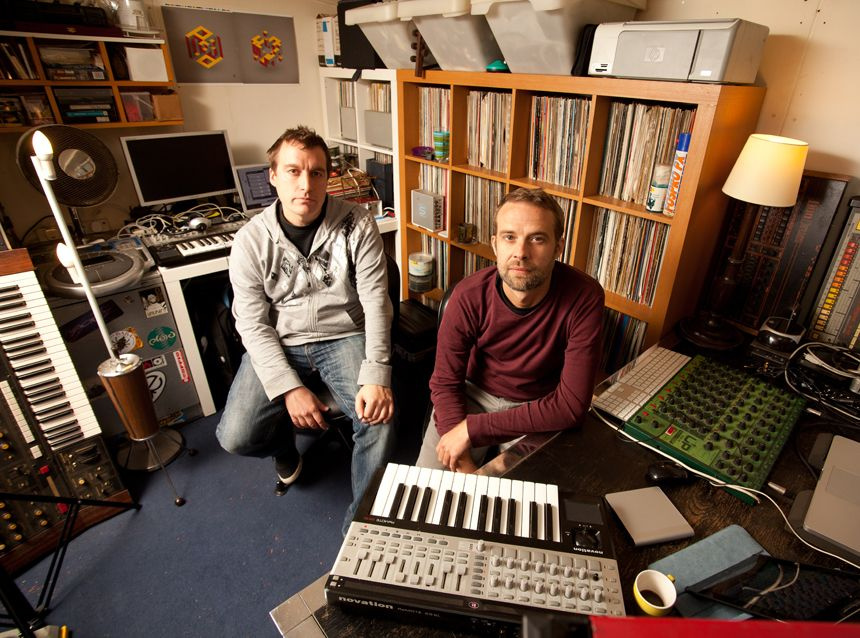Thought this would be a helpful topic to discuss…I personally dont have monitors…and I’m not even sure where to begin in regards to soundproofing my space so that I can spare my neighbors from having to hear dubstep noises…and I remember reading somewhere that with monitors you have to be wary of the position because of unwanted resonance for certain frequencies…so feel free to share your own thoughts about maintaining a studio space.
Thread About setting up studio spaces
I don’t do any of that shit. That’s probably why my music sucks 
A good pair of headphones works for me instead, although you’re not supposed to do that either. I still believe the old adage about car stereo systems telling everything about your mix, even though that’s an awfully shitty medium to consistently rely on. It’s also untrue on many levels.
The top priority for me is accessibility, because if I can’t get my arms around everything when I need it, the creativity demon could fly away before I can press the record button, and for me, writing is the entire meat of what I want to accomplish. If I don’t have a good song, a clean mix won’t help anything.
Some cheap foam D.I.Y treatment can really save time in the mix process, doesn’t cost much, mix with foam frames & wooden reflective panels, check on the net, plenty of tutorials.
Then, after you’ve treated the room you won’t need the most expensive speakers, a decent treatment does a lot in the accuracy of the sound.
So, at the begining, avoid the subwoofer, if you don’t calibrate it correctly (phase, freq accordingly with the response of your room ) you’ll end up with a worse mix.
2 speakers, 60 degrees triangle from your listening position. ( or, ask a friend to move a mirror on each left & right side walls of your listening position, mostof the time, you get a 60 degree isocel triangle) … when you see your face in the mirror, that’s where you should install the speaker.
Some cheap d.i.y treatment, some average speakers, since you’ve treated the room … a good triangle listening position, & you’re sorted.
Nothing too fancy, neither expensive.
Shit in, shit out used to say my teachers, so true, but hey, let’s just acknowledge that we all are genius producer 

It’s just about knowing the rules, once again, to break it to your tastes afterwards 
I know, myself, doing it the wrong way also, i mix with headphones most of the time, my neighboors hate electronic music …
I live in a rental, a rental that was built in 1890 so I have exposed brick in my studio space. Due to the age and history of my place I cannot treat the brick.
I have a monitor switcher that allows me to A/B between a set of Alesis Monitor1 mk2’s and a set of Genelec 8010’s. The Genelec’s allow me to hear what mixes will sound like on small speakers whereas the Alesis are full range.
In order to work around the treatment, I have foam panels that sit upright (mounted to masonite) on the floor, leaning against the wall, covering about 1/3 of the brick. Its been an improvement, but what really did it for me was purchasing and utilizing Sonarworks Reference 4. Its a combination of 2 components. A analyzation app that, using a RTA mic measures the distance between speakers, and takes 22 measurements to create a snapshot of the resonances of your room and mixing sweet spot. One then takes a profile file the app generates and loads it into a VST that lives on ones master bus, effectively “correcting” the room (just make sure you disable it before you render your track out of DAW)
It worked really well for me, i’ve been using it for about 2 years now and my mixes translate to different systems SO much better than before.
At the risk of being a pedant, you’re talking about acoustic treatment, not sound proofing. Sound proofing is keeping sound from exiting the room, and is fuck off expensive and sometimes impossible. Acoustic treatment is reducing the reflections in your space so what comes out the speakers and into your ears is more ‘true’. I only mention this because it might help search terms when doing research.
Past setting up your speakers correctly relative to your listening position, the most important thing to consider when getting going is first reflections. That’s the first bounce point in the room for the sound coming out of your speakers, and it’s the biggest contributor to ‘mud’ and backwash in your listening. They are exactly the mirror points along the walls from your monitors relative to your listening position:
Lots of fancy software and programs to determine them, or you can just have someone move a mirror while you sit in your listening chair and when you can see the monitor in the mirror, treat that spot. There’s also a reflection point on the ceiling above you, but that can be a pain in the ass to treat (I’ve left it alone, ymmv).
Cheapest/easiest solution is insulation batting (Roxel Safe’n’Sound or similar - don’t use the pink shit, it’s not dense enough) stuffed in 1x4 framing with cloth stapled over the it to keep the crap in. Lots of youtube examples:
Bass traps for buildup in corners. That’s primarily behind the monitors, but depends on the dimensions of your room and how close to a wall your desk is. Also depends on things like construction materials of the walls and so on. I wouldn’t worry about any of that until you’ve successfully treating first reflections. Again, youtube ftw on building your own.
From what I’ve read my feeling is that this is something that you either have to do a deep dive/ go all the way or don’t even start bc half assing it will make things worse than doing nothing. I might be 100% wrong, I don’t have that science kind of mind and am not very good at a lot of DIY stuff.
My suggestions for a couple simple things you can do–invest in some kind of isolation stands or pads for you monitors. I was surprised all the resonance I was getting from my desk when I first got my auralex monitor pads. stay away from walls and corners, try to be centered in your room if possible.
As for the neighbors are you in an apartment or sharing a house with roommates? If you are worried about people hearing you in the next house over you are probably monitoring to loud (to mix) anyway (imo).
Also, there is really cool software now that will read your room through a certain kind of microphone and will adjust an EQ on your master channel to adjust what you hear for the acoustics of your room. Maybe @chasedobson mentioned it already.
My monitors also have 3 settings you can switch between that changes the frequency response based on if you are near a wall or corner or more centered in the room. Surprised, but this actually helps a lot in my case.
such settings are exactly why I went with the Presonus Eris 5" monitors. front ported, 3 “dB” settings and another to compensate wall proximity. I then fucked everything up with a 350W 10" sub (also Presonus) and now I have to get my bass-trap on. got two packs of sono-rock in the garage but can’t be arsed.
I was thinking about doing monitors a few months back (decided against it as I’ll be moving in the next year or so) and I was considering Focal shapes. Nice thing about those is they’re very forgiving of room setup. So near a wall or in a corner doesn’t bother them so much. That’ll be the case for anything without a bass port.
I’d aim, above all, to have a space you can be comfortable getting work done in. For me, that means laying in bed working on my laptop next to a rack of synthesizers that I use to write and do sound design experiments. I use a USB DAC/headphone amp and a set of decent headphones, and a $5 mouse on an old Guiness World Records book as a mousepad. Not to brag, but I think most of you have seen my work and I’m doing something right.
In my dreams, I’d have an actual desk and chair I could sit at (though I’ve done that a few times and it feels weird for me because I’ve been doing music this way so long) with monitors and a treated room with plenty of space to move around. But clearly, my music cocoon works, and I think that’s because I’m comfortable in that space, little as it may be.
So if comfort means you need to compromise on something else, I’d do it. Yes, even monitor placement, sound treatment, and gear.
I agree to a point there, but I would put it like “if it gets in the way of your creative flow, really consider if you need to do it that way.” I had to learn some dicipline in music making to get some shit done over the years as comfortable was nice, but not always productive. 
Also, I have my PC on one wall but cleaned up my office a bit and now have my synths on the opposite wall, as I want to be trying more “hands on” and getting away from the PC. I have ended up putting a lappy over there though, but I sit on a stool thingy, my synths are on a coffee table, and I can look out the window while working. I am going to try to use that side to create, and the PC side to mix and see how it goes for a while.
Haven’t actually read any of the posts on this thread yet, I just had a quick search for anything on here about home studios right now this popped up so I thought it would be the right place to ask my question.
Basically I’ve never had a home studio setup. I’ve never even mixed on speakers before, and I’ve been making stuff for nearly 5 years now. I know, I know, mixing on headphones is bad practice. Problem was that I never had a permanent place to live. In the last 5 years I’ve moved to 3 different countries and might still be on the move for another few years to come potentially so setting up a home studio wasn’t an option, neither was lugging speakers halfway around the world with me, and all the places I lived were apartments with thin walls where I couldn’t use speakers cause of neighbours and roommates even if I did have some.
Anyways in the future I do wanna set something up. I was wondering if anyone has any opinions on using a garden shed as a studio?
The great and mighty Plaid have their studio setup in a shed, or at least they did in 2011 when this article was published. And they didn’t seem to have any problems.
https://www.musicradar.com/news/tech/in-pictures-plaidss-studio-in-a-shed-519521
Would a garden shed though not be bad for electronic equipment. Especially in a country like England where it rains a lot of the time. Wouldn’t water or damp or things be bad for the equipment? Any have any experience good or bad with this kind of studio setup?
Cheers



